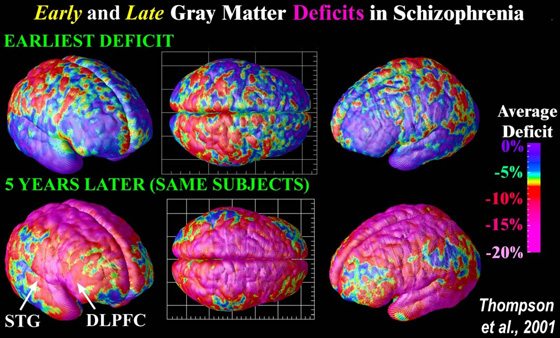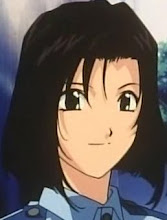
Monday, March 30, 2009
Schizophrenia types include:
Paranoid schizophrenia
Disorganized (hebephrenic) schizophrenia
Catatonic schizophrenia
Residual schizophrenia
Undifferentiated disorder.
Paranoid Schizophrenia
Paranoid schizophrenia is the most common form. With this type of schizophrenia, the primary symptoms are delusions or auditory hallucinations. People with paranoid schizophrenia usually do not have thought disorder, disorganized behavior, or affective flattening.
People with this condition have grandiose delusions. For example, they may believe that others are deliberately:
Cheating them
Harassing them
Poisoning them
Spying upon them
Plotting against them or the people they care about.
Auditory hallucinations can include hearing "voices" that may:
Comment on the person's behavior
Order him or her to do things
Warn of impending danger
Talk to each other (usually about the affected person).
Disorganized Schizophrenia
People with this schizophrenia type often have unusual thought processes. One dramatic form is disorganized thinking, where the person may have difficulty organizing thoughts or connecting them logically. Speech may be garbled or hard to understand. Another form is "thought blocking," where the person stops abruptly in the middle of a thought. When asked, the person may say it felt as if the thought had been taken out of his or her head. Finally, the individual might make up unintelligible words, or "neologisms."
A person with this form of schizophrenia also has disorganized behavior and flat or inappropriate affect (such as immobile facial expression and monotonous voice).
Catatonic Schizophrenia
People with this type of schizophrenia can be clumsy and uncoordinated. They may also show involuntary movements, grimacing, or unusual mannerisms. They may repeat certain motions over and over or, in extreme cases, may become catatonic. Catatonia is a state of immobility and unresponsiveness that was more common when schizophrenia treatment was not available. Fortunately, catatonia is now rare.
Residual Schizophrenia
Residual schizophrenia can occur in people with long-term schizophrenia. With this schizophrenia type, a person no longer shows positive symptoms (hallucinations, delusions, disorganized speech, and grossly disorganized or catatonic behavior), but still shows negative symptoms, which can include:
Flat affect (for example, immobile facial expression and monotonous voice)
Lack of pleasure in everyday life
Diminished ability to initiate and sustain planned activity
Speaking infrequently, even when forced to interact.
People with residual schizophrenia often neglect basic hygiene and need help with everyday living activities.
Undifferentiated Schizophrenia
With this type of schizophrenia, a person meets the criteria to be diagnosed with schizophrenia, but his or her symptoms are not consistent with any of the other forms of the disease.
Paranoid schizophrenia
Disorganized (hebephrenic) schizophrenia
Catatonic schizophrenia
Residual schizophrenia
Undifferentiated disorder.
Paranoid Schizophrenia
Paranoid schizophrenia is the most common form. With this type of schizophrenia, the primary symptoms are delusions or auditory hallucinations. People with paranoid schizophrenia usually do not have thought disorder, disorganized behavior, or affective flattening.
People with this condition have grandiose delusions. For example, they may believe that others are deliberately:
Cheating them
Harassing them
Poisoning them
Spying upon them
Plotting against them or the people they care about.
Auditory hallucinations can include hearing "voices" that may:
Comment on the person's behavior
Order him or her to do things
Warn of impending danger
Talk to each other (usually about the affected person).
Disorganized Schizophrenia
People with this schizophrenia type often have unusual thought processes. One dramatic form is disorganized thinking, where the person may have difficulty organizing thoughts or connecting them logically. Speech may be garbled or hard to understand. Another form is "thought blocking," where the person stops abruptly in the middle of a thought. When asked, the person may say it felt as if the thought had been taken out of his or her head. Finally, the individual might make up unintelligible words, or "neologisms."
A person with this form of schizophrenia also has disorganized behavior and flat or inappropriate affect (such as immobile facial expression and monotonous voice).
Catatonic Schizophrenia
People with this type of schizophrenia can be clumsy and uncoordinated. They may also show involuntary movements, grimacing, or unusual mannerisms. They may repeat certain motions over and over or, in extreme cases, may become catatonic. Catatonia is a state of immobility and unresponsiveness that was more common when schizophrenia treatment was not available. Fortunately, catatonia is now rare.
Residual Schizophrenia
Residual schizophrenia can occur in people with long-term schizophrenia. With this schizophrenia type, a person no longer shows positive symptoms (hallucinations, delusions, disorganized speech, and grossly disorganized or catatonic behavior), but still shows negative symptoms, which can include:
Flat affect (for example, immobile facial expression and monotonous voice)
Lack of pleasure in everyday life
Diminished ability to initiate and sustain planned activity
Speaking infrequently, even when forced to interact.
People with residual schizophrenia often neglect basic hygiene and need help with everyday living activities.
Undifferentiated Schizophrenia
With this type of schizophrenia, a person meets the criteria to be diagnosed with schizophrenia, but his or her symptoms are not consistent with any of the other forms of the disease.
Subscribe to:
Comments (Atom)
